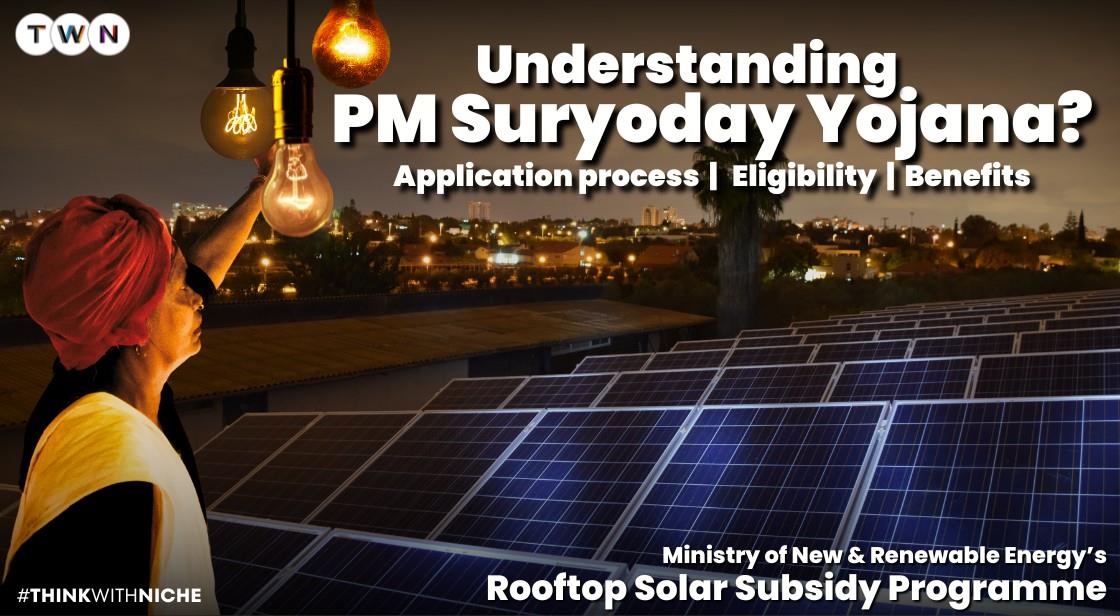Understanding Pradhan Mantri Suryoday Yojana: Application process, Eligibility and Benefits

Blog Post
Taking a big step towards green energy, in January 2024, Prime Minister Narendra Modi announced the "Pradhan Mantri Suryodaya Yojana", which has the potential to transform India's energy landscape. It is noteworthy that in the budget of 2024-25, Finance Minister Nirmala Sitharaman had mentioned this scheme, the aim of which is to install solar energy systems (solar panels) in 1 crore houses across the country.
Pradhan Mantri Suryodaya Yojana will not only promote clean energy, but will also contribute significantly to economic growth, environmental sustainability and energy security.
This ambitious plan of the government is a first effort to take the country towards energy self-sufficiency. According to statistics, India currently imports more than 80% of its oil needs, causing energy security to be affected by foreign market fluctuations.
In such a situation, it is in the national interest to promote clean and renewable energy sources at the domestic level. Solar panels installed in homes under the Pradhan Mantri Suryodaya Yojana will not only help them save on electricity bills but can also contribute additional power to the national grid, thereby reducing the problem of power cuts.
The beneficiaries of Pradhan Mantri Suryodaya Yojana will be poor and middle class families whose annual income is less than Rs 1.5 lakh. Under the scheme, the government will provide up to 40% subsidy for installation of solar panels, which will make it easier for economically weaker people to avail the benefits of solar energy.
Apart from this, self-employment opportunities will also be created in solar panel manufacturing and installation, which will open new avenues of employment for the youth.
By adopting solar energy, India is also trying to reduce environmental pollution by reducing carbon emissions. Currently, India is the third largest carbon emitter in the world. This scheme can play an important role in reducing these emissions.
Solar energy, being a clean and renewable source, reduces harm to the environment.
To make “Pradhan Mantri Suryodaya Yojana” successful, the Central and State Governments will have to work together. While the central government will provide the necessary funds for this scheme, the state governments will have to take the responsibility of its implementation. Also, it is important to make people aware about the benefits of solar energy and provide correct information about the scheme.
In this sequence, while ensuring its commitment of being a knowledge sharing platform, Think with Niche is sharing the available important information related to Suryodaya Yojana with its readers in this blogpost as a contribution to make this public utility and revolutionary initiative successful so that it can reach maximum people. So that its benefits can reach and this scheme can achieve its desired goals.
Think with Niche believes that Pradhan Mantri Suryoday Yojana is an important step for India. This scheme will not only promote energy security, environmental protection and economic development, but will also help in improving the living standards of the people.
Pradhan Mantri Suryoday Yojana: Everything You Need to Know
Pradhan Mantri Suryodaya Yojana: Rise of the Solar Revolution
The government in India is working to improve the lives of its people by making new schemes. India's Pradhan Mantri Suryodaya Yojana is an important step towards sustainable development and self-reliance. This government initiative, aimed at providing solar panels to one crore homes, not only promotes economic growth and self-employment, but also advances the energy sector, especially in rooftop solar panel manufacturing.
By adopting solar energy, India is actively reducing its dependence on non-renewable resources, while promoting environmental sustainability. This blog will highlight the transformative impact of Pradhan Mantri Suryodaya Yojana on solar panel manufacturing in the energy sector.
Pradhan Mantri Suryoday Yojana: After Ram temple's life consecration on 22 January 2024, Prime Minister Narendra Modi has taken the first step towards green energy. As soon as PM Modi reached his residence in Delhi after returning from Ayodhya, he promised to provide solar panels to 1 crore houses across the country.
Let us first know that:
Why is solar energy so important for India?
India needs solar energy because-
To understand the importance of solar energy in India, we first have to understand the energy situation of the country. Currently, India meets more than 80% of its energy requirements from fossil fuels. This is not only harmful to the environment, but also a threat to energy security.
Solar energy is a clean and renewable energy source that can play an important role in meeting the energy needs of India.
Let us know why solar energy is so important for India:
India, with its burgeoning population and expanding economy, faces a dual challenge: meeting its ever-growing energy demands while transitioning to a sustainable future. In this scenario, solar energy emerges as a beacon of hope, offering a plethora of benefits that make it crucial for the nation's progress.
1. Combating Climate Change:
India is one of the largest emitters of greenhouse gases, and solar energy provides a clean alternative to fossil fuels. Replacing traditional sources with solar power can significantly reduce carbon emissions, mitigating climate change and its detrimental effects.
2. Energy Security and Independence:
India heavily relies on imported fossil fuels, making it vulnerable to price fluctuations and geopolitical disruptions. Solar energy, being indigenous and abundant, reduces dependence on foreign imports, bolstering energy security and self-reliance.
3. Addressing Peak Demand:
India experiences peak demand periods, often leading to power outages. Decentralized solar power generation on rooftops can alleviate this stress on the grid by feeding energy directly into distribution networks, enhancing grid stability and reliability.
4. Cost-Effectiveness and Affordability:
The cost of solar panels has fallen drastically in recent years, making them increasingly affordable for individuals and businesses. Additionally, government schemes like Pradhan Mantri Sahaj Solar Yojana provide subsidies and loans, further promoting solar adoption.
5. Job Creation and Economic Growth:
The burgeoning solar industry is generating numerous employment opportunities in manufacturing, installation, and maintenance. This not only empowers communities but also contributes to the overall economic growth of the nation.
6. Rural Electrification and Inclusive Development:
Millions in rural India lack access to reliable electricity. Solar-powered microgrids can bridge this gap, providing clean and sustainable energy to remote areas, fostering inclusive development and improving living standards.
Recent Developments:
-
India has set an ambitious target of achieving 175 GW of installed solar capacity by 2022 and 500 GW by 2030, witnessing rapid growth in the sector.
-
Innovative financing models like rooftop solar bonds and green infrastructure investment trusts are attracting larger investments, accelerating solar adoption.
-
Technological advancements in areas like bifacial panels and energy storage are further enhancing the efficiency and affordability of solar solutions.
What were Prime Minister Modi's remarks regarding the Suryoday Yojana?
On the evening of January 22, the Prime Minister posted on the social media platform Indians should have their own solar systems on their rooftops."
PM Modi further wrote, 'After returning from Ayodhya, I have decided that our government will start 'Pradhan Mantri Suryodaya Yojana' with the target of installing solar panels on 1 crore houses. This will not only reduce the electricity bill of the poor and middle class, but will also make India self-reliant in the field of energy."
What is Pradhan Mantri Suryodaya Yojana?
Pradhan Mantri Suryodaya Yojana is a game-changer for Indian households and energy industries. Pradhan Mantri Suryodaya Yojana's target of providing solar panels to one crore homes not only promotes clean energy but also reduces electricity bills. Solar energy is key in this initiative, which offers many benefits to home owners and creates opportunities for MSMEs in manufacturing rooftop solar panels.
Due to its installation, there will be a reduction in the cost of electricity, and from there, people will be supplied with electricity connections right from recruitment to bills.
Regarding this, PM Modi created the website of the concerned department at his residence on Lok Kalyan Marg in Delhi and said that those who have roofs in their houses, they will get the benefit of sun's energy and the electricity bill will also be reduced. He also said that with this step of the government, India can be made self-reliant by using the principle of electricity.
Apart from this, people who have rooftop space in their homes can also use it in a similar manner. At the same time, the advantage of solar rooftop system is that it does not require heavy cash expenditure again and again. After spending a little in the beginning, once the solar panels are installed on your roof, there is no need to spend much. There is very less cost in maintenance also.
Objectives of Pradhan Mantri Suryoday Yojana
The primary objective of Pradhan Mantri Suryodaya Yojana is to provide a reliable source of electricity to rural and urban households through solar panels. By reducing their dependence on non-renewable sources of energy, Pradhan Mantri Suryodaya Yojana aims to contribute to economic growth, self-employment and manufacturing of solar panels. This initiative not only benefits families but also boosts the energy sector, creates employment opportunities and promotes technological innovation.
How to apply online for Pradhan Mantri Suryoday Yojana?
However, the government has not yet announced any official website, portal or any process for this. A portal regarding this will be released soon. But, its application will be made on the government portal National Portal for Rooftop Solar. Let's find out how
1. To apply under this new scheme, you will have to go to the official portal of the government and enroll.
2. As soon as you register, your account will be created. You have to login there and necessary information like electricity consumer number, mobile number and e-mail ID can be asked, which you have to upload and submit.
3. After this you will get the list of registered vendors from the government who are available in your area.
4. After selecting the vendor in the list, your application will reach the DISCOM for approval.
5. As soon as you get approval from DISCOM, you will be able to install the solar plant.
6. As soon as the solar plant is installed, you have to submit the details of the plant on the official website and apply for a net meter.
7. Final step. You have to submit bank details and canceled check through the portal only. The benefits provided by the government will reach you within a few days.
What is DISCOM?
In India's complex power sector, understanding DISCOMs is crucial. But what exactly are they? DISCOM stands for Distribution Companies, playing a vital role in delivering electricity to your home or business. Let's delve deeper into their functions, recent developments, and their significance in the ever-evolving energy landscape.
What do DISCOMs do?
Think of DISCOMs as the final link in the power chain. They purchase electricity from generation and transmission companies and distribute it to consumers through a network of substations, lines, and transformers. Their responsibilities include:
-
Metering and billing: Installing and maintaining meters, calculating and collecting electricity bills.
-
Network maintenance: Ensuring the efficient functioning of the distribution infrastructure.
-
Customer service: Addressing consumer queries and complaints related to billing, power outages, etc.
-
Demand management: Implementing strategies to manage peak demand and optimize power usage.
Recent developments in the DISCOM landscape:
-
Financial health: Many DISCOMs face financial challenges due to various factors. Government initiatives like UDAY aim to improve their financial health and operational efficiency.
-
Smart grid integration: DISCOMs are increasingly adopting smart grid technologies to improve reliability, reduce losses, and enable better demand management.
-
Renewable energy integration: DISCOMs play a crucial role in integrating renewable energy sources like solar into the grid.
Why are DISCOMs important?
They form the backbone of the power delivery system, impacting millions of consumers daily. Efficient DISCOMs contribute to:
-
Enhanced energy access: Reaching even remote areas and bridging the electricity gap.
-
Improved power quality: Ensuring reliable and stable electricity supply.
-
Reduced electricity costs: Implementing measures to control costs and minimize losses.
-
Sustainable energy transition: Facilitating the integration of renewable energy sources.
Prime Minister Suryoday Yojana Eligibility
What is the qualification required to apply?
1. Must be a permanent resident of India
2. The annual income of the person applying should not exceed Rs 1.5 lakh.
3. No member of the family of the person applying should be a government employee or income tax payer.
Important documents for Pradhan Mantri Suryoday Yojana
If you also want to install solar panels in your house under Pradhan Mantri Suryodaya Yojana, then you can get information about some of the documents mentioned below. For this, complete information can be available after the release of the portal by the government. The Prime Minister has taken this decision very quickly, it is expected that the government will start the entire process soon. In such a situation, you should be ready with all the documents and apply them in time.
- Aadhar card
- Income certificate
- Address proof
- Ration card
- Electricity bill
- Mobile number
- Bank details
- Passport size photo
Who will be the beneficiaries of Suryoday Yojana?
This decision taken by the Prime Minister on the same day after the consecration of Ram temple is for low and middle income people. That is, under this scheme, electricity is supplied to the homes of lower-middle income class people through solar energy.
What is the present condition of solar distribution?
According to the official website of the Ministry of New and Renewable Energy, India's solar energy capacity has reached about 73.31 GW by December 2023. Meanwhile, rooftop solar capacity by December 2023 is about 11.08 GW.
The National Rooftop Scheme currently run by the Center provides financial assistance of 40 per cent of the total cost of solar rooftop projects.
Significance of solar panels in the Pradhan Mantri Suryodaya Yojana
Solar panels play an important role in the Pradhan Mantri Suryodaya Yojana, as they serve as the primary source of solar energy generation. Pradhan Mantri Suryodaya Yojana's emphasis on solar panel manufacturing is a strategic step towards promoting renewable energy and achieving environmental sustainability. Solar energy is a clean and abundant resource that can be used to meet India's growing energy demands. By manufacturing solar panels, India not only reduces its carbon footprint but also ensures a reliable and sustainable energy source for its citizens.
Government agencies involved in solar energy in India
Solar Energy Corporation of India:
Solar Energy Corporation of India Limited (SECI) is a government enterprise formed by the Ministry of New and Renewable Energy to support the work of the National Solar Mission (NSM). It is the first Central Public Sector Undertaking (PSU) completely dedicated to solar energy. The scope of the firm has been expanded to include the entire renewable energy domain, and the company will be called Renewable Energy Corporation of India (RECI). SECI has also ventured into turnkey solar project development for various PSUs.
Government subsidies for household solar panels
Solar systems are required to harness solar energy. Solar panel subsidies are also required to match the prices and expenses for installing a solar system. To meet these financial criteria, the government offers various solar panel subsidies to help you control your expenses and install a rooftop solar system cheaply. Keeping this in mind, the Government of India has launched a project named Solar Rooftop Power Plant. This campaign mainly encourages individuals to use solar energy to conserve energy and reduce the demand for other fuels.
Benefits of Solar Panel Subsidy:
Installing a solar system requires significant financial investment. In such cases, solar subsidy provides financial assistance and relieves you from the burden.
The amount offered by the government varies depending on the kilowatts of electricity generated by the solar system. For example, solar panel subsidy for up to 3kW is 40% of the total cost, while for 4kW to 10kW it is 20%. You choose the subsidy based on your needs.
Use the subsidy to build a solar system on your rooftop. You can get additional incentive of Rs. 1 per unit on the total solar energy generated on your annual electricity bill.
Solar panel subsidy to be available in Budget 2024
In a significant step to promote solar energy adoption among residential consumers, the Government of India has announced an increase in Central Financial Assistance (CFA) subsidy by 23% till January 2024. Solar subsidy cashback under MNRE (Central Subsidy Scheme) has been increased to Rs 18,000 per kW (from previous Rs 14,588/kWh) for residential solar rooftop systems between 1-3 kW capacity.
Know when solar panel subsidy will end
The government has extended the solar subsidy date to March 31, 2026. Under this scheme, homeowners who install solar panels on their rooftops before this deadline are eligible for financial incentives. This initiative is an important part of a comprehensive strategy aimed at increasing solar energy.
Top 10 Solar Panel Manufacturers in India (2024)
Leading players in the market are contributing significantly to this initiative. Manufacturers play a vital role in driving the adoption of solar panels across the country. It is important to highlight the contribution of these manufacturers to this initiative, showcasing their expertise and commitment to sustainable energy solutions.
The solar energy sector is developing rapidly in India and the demand for solar panels is continuously increasing. In 2024, there are many solar panel manufacturers in India that produce high quality panels.
Here is the list of top 10 solar panel manufacturers in India (2024):
1. Tata Power Solar:
Tata Power Solar is the largest solar panel manufacturer in India. The company has been producing solar panels since 1989 and has installed more than 4.6 GW of solar panels.
2. Adani Green Energy:
Adani Green Energy is the second largest solar panel manufacturer in India. The company has been producing solar panels since 2015 and has installed more than 3.5 GW of solar panels.
3. Very solar:
Very Solar is the third largest solar panel manufacturer in India. The company has been producing solar panels since 2007 and has installed more than 3 GW of solar panels.
4. Wary Energy:
Veri Energy is the fourth largest solar panel manufacturer in India. The company has been producing solar panels since 1989 and has installed more than 2.5 GW of solar panels.
5. Loom Solar:
Loom Solar is the fifth largest solar panel manufacturer in India. This company has been producing solar panels since 2012 and has installed more than 2 GW of solar panels.
6. Vikram Solar:
Vikram Solar is the sixth largest solar panel manufacturer in India. The company has been producing solar panels since 2006 and has installed more than 1.5 GW of solar panels.
7. Jindal Solar:
Jindal Solar is the seventh largest solar panel manufacturer in India. This company has been producing solar panels since 2010 and has installed more than 1 GW of solar panels.
8. Goldi Solar
Established: 2011 Headquarters: Surat, Gujarat Founder & MD: Ishwar Dholakia
Goldi Solar is one of the fastest growing solar panel manufacturers in India. The company produces high quality solar panels that are available at competitive prices. Goldi Solar also provides excellent customer service.
Goldi Solar can be included in the list of top 10 solar panel manufacturers in India.
9. Rinusis India:
Rinusis India is the ninth largest solar panel manufacturer in India. The company has been producing solar panels since 2008 and has installed more than 0.5 GW of solar panels.
10. Patanjali Renewable:
Patanjali Renewable is the tenth largest solar panel manufacturer in India. This company has been producing solar panels since 2017 and has installed more than 0.5 GW of solar panels.
It is important to note that this list is only approximate and the ranking of solar panel manufacturers may change over time.
Conclusion
Pradhan Mantri Suryodaya Yojana stands as a transformative initiative poised to revolutionize the Indian energy landscape. With a commitment to installing solar panels in one crore homes, this scheme spearheaded by Prime Minister Narendra Modi not only champions clean and renewable energy but also addresses economic growth and self-reliance.
The significance of solar energy for India is underscored by the country's heavy reliance on fossil fuels, contributing to environmental degradation and energy security concerns. Pradhan Mantri Suryodaya Yojana aims to tackle these challenges by encouraging the adoption of solar panels, particularly among low and middle-income families.
Solar panels play a pivotal role in this initiative, serving as the primary source of solar energy generation. By emphasizing the manufacturing of rooftop solar panels, the scheme promotes self-employment opportunities and contributes to the overall growth of the solar industry. The move towards renewable energy aligns with India's ambitious targets of achieving 175 GW of installed solar capacity by 2022 and 500 GW by 2030.
Government subsidies, including the increased Central Financial Assistance (CFA) subsidy, further incentivize individuals to embrace solar energy. The extended deadline for solar panel subsidies until March 31, 2026, provides homeowners with financial incentives to contribute to the nation's solar energy goals.
Pradhan Mantri Suryodaya Yojana not only holds the promise of reducing electricity bills and making India self-reliant in the energy sector but also signifies a comprehensive strategy for environmental sustainability, economic development, and improved living standards. As India moves towards a greener and more sustainable future, the importance of initiatives like Pradhan Mantri Suryodaya Yojana cannot be overstated.
You May Like
EDITOR’S CHOICE












